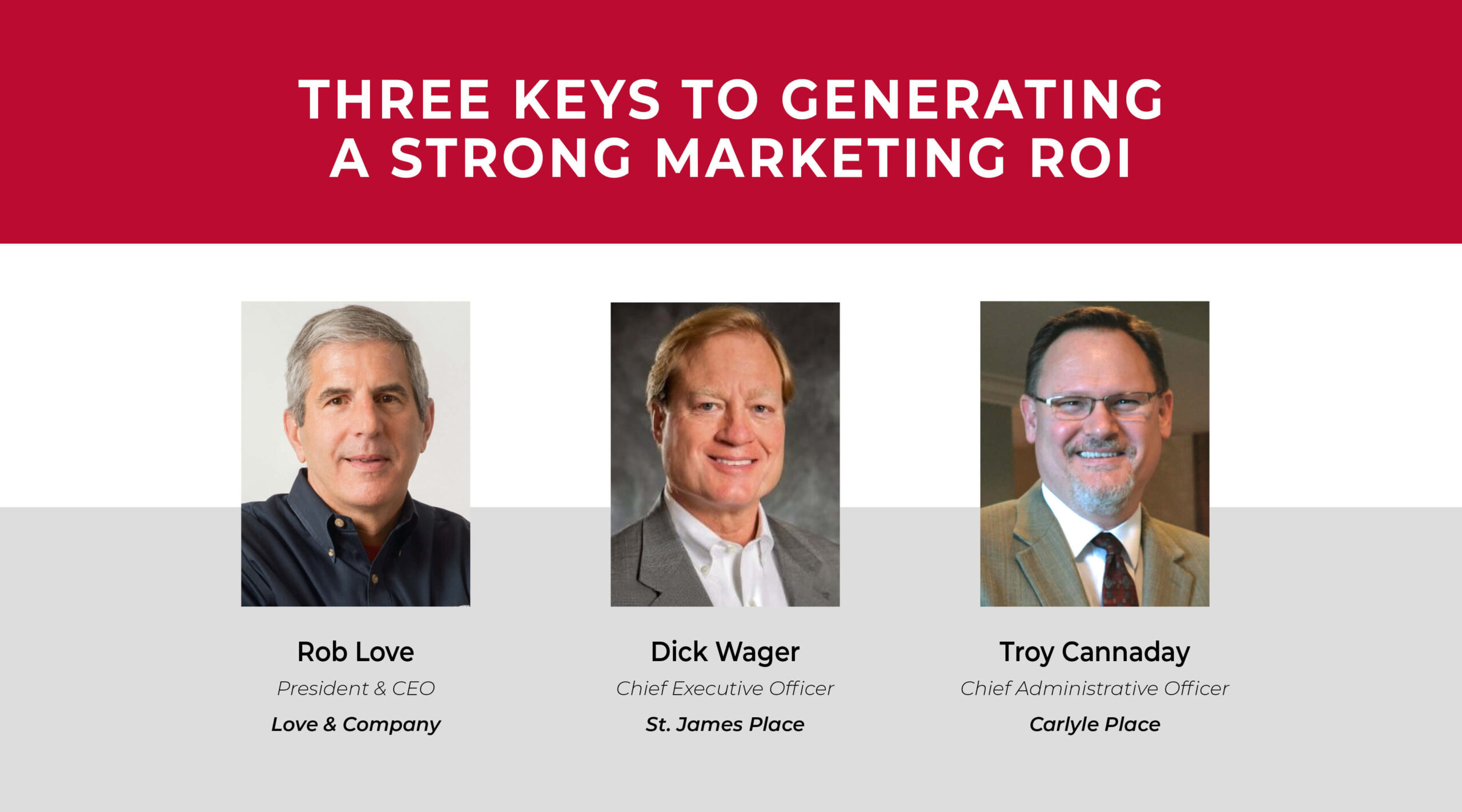In 20+ years helping Life Plan Communities develop marketing plans, my recurring challenge is helping leadership teams embrace that marketing is an investment and not an expense. I understand a CEO’s or CFO’s hesitancy to “spend money to make money.” The concept of marketing ROI makes intellectual sense; but when occupancy is low and operational expenses are high, everyone has trouble spending precious resources on marketing … especially when move ins have plateaued or declined year after year.
That’s why I appreciate two clients who recently took the helm of Life Plan Communities that had occupancy levels around 70% … and quickly steered them back to more than 95%. In doing so, Chief Administrative Officer Troy Cannaday of Carlyle Place and Chief Executive Officer Dick Wager found the secret to investing in marketing with confidence—and experiencing an ROI of 1,000+% (yes, you’re reading that correctly).
The Light Bulb Moment
Troy and Dick understood the common denominator to all occupancy turnaround success stories is this: The root cause is never one thing. Focusing on individual tactics or issues in isolation lacks long-term impact. Census shortfalls invariably involve the interplay of multiple factors, not just the factors themselves. This interdependency is why (for just a few examples):
- Perfecting your branding and messaging goes wasted if your media plan fails to get your ads in front of the right audience.
- Improved lead generation wastes money if your sales team can’t convert them to appointments.
- Generating more appointments loses sales if your product, pricing and visitor experience are wrong.
Untangling this interplay of factors and prioritizing where to invest, and in what order, is what allowed Troy and Dick to turn inherited occupancies near 70% into full communities within three years. They were kind enough to tell their story in their own words in this webinar on The 3 Keys to Marketing ROI. Both stories focus on the big picture relationship between messaging, lead generation and sales as the key to sustainable improvement.
Is This the Silver Bullet for Senior Living Marketing?
Determining which investments and improvements will have the largest impacts, and how long it will take each improvement to take hold, is the key. Every situation is unique, but our experience suggests that virtually every occupancy success story originates in one common step—a formal assessment.
We agree there’s no silver bullet in Life Plan Community when considering individual tactics and strategies like adding a training course, a web tool or a particular messaging strategy. But the disciplined process of assessing a sales and marketing program holistically and with fresh eyes is consistently the way to rebuild occupancy.
So, I maintain the “senior living silver bullet” is doing a deep dive into how each part of your program interacts with the others and then prioritizing which factors must be addressed, and in what order.
Marketing ROI You Can Bank On
This brings me back to the key to the 1,000+% marketing ROI I referenced.
Our initial deep dive into Carlyle Place and St. James Place showed Troy and Dick how and why—in their different situations—investing in an initial focus on messaging was going to impact lead generation in volume and quality, while also showing how a strengthened sales approach would better convert the new influx of leads. These leaders saw how the interplay of increased marketing investments during these turnaround years would work together, allowing them to make their incremental investments with confidence.
The results speak for themselves:
- Carlyle Place increased its marketing investment for a three-year period by 46% (roughly $128,000 a year), which generated a …
- 94% increase in annual net move ins (16 additional move ins a year)
- 100% increase in annual net entrance fees (roughly $4.3 million a year), plus the annualized revenue of the net gain in new monthly fees
- 3,357% return on its incremental increase in marketing investment
- St. James Place increased its marketing investment for a three-year period by 65% (roughly $356,000 a year, including adding a sales FTE), which generated a …
- 65% increase in annual net move ins (13 additional move ins annually)
- 76% increase in annual net entrance fees (roughly $4.3 million a year), plus the annualized revenue of the net gain in new monthly fees
- 1,210% return on its incremental increase in marketing investment
Where to Start
A truly holistic assessment does a few things that benefit both full and low-occupancy communities. An assessment:
- Identifies what you’re doing well, so you can reinforce your strengths.
- Shines a fresh light on parts of your community, operations, programming, pricing and product that you’ve grown so accustomed to that you don’t even notice anymore.
- Brings attention to untapped opportunities and newly available best practices that will become essential in the future, even if their absence didn’t hurt you in the past.
- Provides direction on professional development that will benefit your organization and your team members alike.
This is why we hear the same thing from our assessment clients that sales teams hear from their residents: “I wish I had done it sooner.” Now that Troy has seen the turnaround benefits of an assessment, he’s telling his peers, “I think everyone should do an assessment every five years, regardless of where your occupancy is. Do it to stay on top of your game.” We agree, Troy!
Contemplating getting some fresh eyes on your sales and marketing program? I encourage you to explore case studies like St. James Place, Carlyle Place or Westerwood, or read Episcopal SeniorLife Communities’ story. Of course, you can always reach out to us—we love helping people figure out how to ensure marketing can be a genuine investment, not an expense. When you’re ready, email Tim Bracken or me—we’d love to hear your story.





